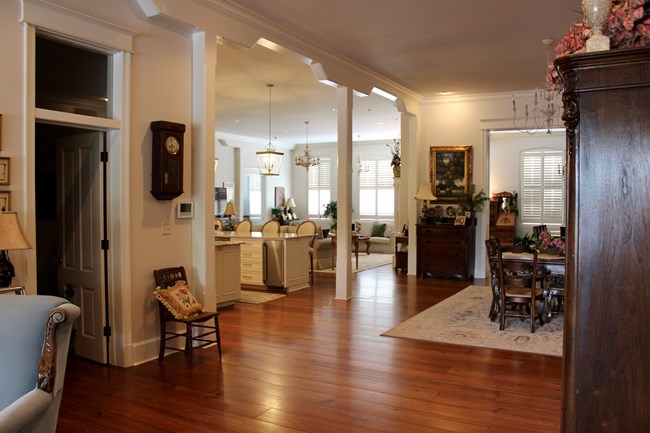Last updated: March 30, 2023
Article
Case Study: Thomson-Lyons Implement Company Building, Crowley, Louisiana

COURTESY/KARA BERGERON

COURTESY/KARA BERGERON
History and Downtown Context
The building was constructed in 1902 by Henry Loewer and is stylistically much like the larger, more ornate, and better-known Crowley Grand Opera House built across the street in the same year. The building was first occupied by the Thomson-Lyons Implement Company, Ltd., which sold such items as buggies, plows, harnesses, and threshers to local farmers. (Crowley is an agricultural community located in the southwestern part of the state and is known as the “Rice Capital of America.”) The building housed numerous other businesses, including hardware and furniture stores over the years, and a jewelry store established in the early 1950s that is still in operation today.Lazar John Properties purchased the historic building in 2002 and began the rehabilitation of the property in 2014 to renovate the first-floor retail and turn the second floor into housing. The second floor, which was unfinished, as it had been used primarily for storage for the ground-floor businesses, was converted from warehouse space to a rental apartment unit.
Scope of the Rehabilitation
The building was originally constructed with 18-inch-thick exterior brick walls, and the interior was supported by wood columns and beams on the first and second floors. As part of the rehabilitation, the exterior brick walls were stripped of 20-year-old paint and repointed where necessary. The original historic windows were repaired and repainted. The beams and columns were repaired, cleaned, and preserved, along with original plaster finishes and exposed brick walls where they remained in the building. New electrical and plumbing was installed as required by state and local codes. New walls were created on the second floor to create three bedrooms, but two-thirds of the apartment space were left unobstructed, with an open floor plan and exposed columns, beams, wood floors, plaster, and brick that characterized the former warehouse space.Role of the Historic Tax Credit
Developer LJ Gielen remarked that “This project would have been cost prohibitive had it not been for the availability of the Federal and state tax credits. Restoring historic buildings is usually more expensive than building from the ground up. However, when you take a blighted building that is historic and bring it back to life it is a wonderful opportunity to save the past for future generations. Without the tax credits we would not have embarked on this rehabilitation.”Economic Impact on Downtown Crowley
First sparked by the restoration of Crowley’s Grand Opera House in 2008, the rehabilitation of historic buildings is propelling revitalization and economic development in the commercial downtown area of the Crowley Historic District. Rehabilitating the Thomson-Lyons Implement Company Building is a vital step in catalyzing more downtown development in Crowley, which is the parish seat of Acadia Parish. The value of this historic building has significantly increased as a result of its rehabilitation, and the City has invested in public infrastructure, as well as main street events and other amenities, to enhance the appeal of the downtown. These efforts are making a difference by informing building owners of revitalization incentives like historic tax credits. The City and local chamber of commerce are focused on increasing foot traffic and reinvigorating downtown as an exciting destination and community gathering place. Along with other buildings owned by Lazar John Properties, which received façade grants from the State of Louisiana, two other developers have begun renovating buildings close by. Due to the growing downtown appeal, new businesses have started locating in downtown Crowley, and residents are looking for places to remodel in order to live downtown.Learn More
Fiscal Year 2018 Highlights and Reports
- Federal Tax Incentives for Rehabilitating Historic Buildings Annual Report for Fiscal Year 2018
- Annual Report on the Economic Impact of the Federal Historic Tax Credit for Fiscal Year 2018
Additional Case Studies
- Case Study: 17 Alfred Street (Biddeford, Maine) In a city that has long suffered from a significant commercial vacancy rate, 17 Alfred Street has been fully occupied since completion of both the residential and commercial spaces. The entire block is now filled with businesses that complement each other and are starting to bring more people into downtown Biddeford (pop. 21,488). The rehabilitation of 17 Alfred Street is helping fuel Biddeford’s resurgence and is encouraging other downtown building owners to explore historic rehabilitation solutions.
- Case Study: Cheney High School (Cheney, Washington) School House Lofts’ rehabilitation of the former Cheney High School now provides contemporary and fun living spaces within a cherished historic building and a community icon. It not only provides much-needed student housing at Eastern Washington University, but also reduces automobile use and alleviates parking on-campus, given its close proximity. The project also breathed new life into the vacated high school and supports continuity in the neighborhood by blending a large historic building into a residential section of Cheney (pop. 12,446).
- Case Study: Germania Building (Milwaukee, Wisconsin) The rehabilitation of the Germania is a major milestone for development in the City of Milwaukee and the Central Business District (CBD). The need for additional affordable housing in the CBD and greater downtown area is acute, and the Germania demonstrates that high-quality rehabilitations of historic buildings can help fill this need. By involving unemployed and underemployed city residents to work on the building, the project also created jobs and trained people to start new careers.
